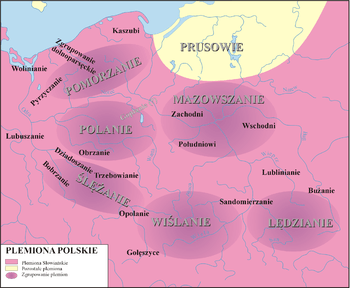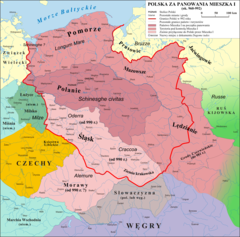Lendians
The Lendians (Polish: Lędzianie) were a Lechitic tribe who lived in the area of East Lesser Poland and Cherven Towns between the 7th and 11th centuries. Since they were documented primarily by foreign authors whose knowledge of Central and East Europe geography was often vague, they were recorded by different names, which include Lendzanenoi, Lendzaninoi, Lz’njn, Lachy, Landzaneh, Lendizi, Licicaviki and Litziki.
Sources
| Sources mentioning Lendians: Annales regni Francorum (805), Annales Mettenses (805), Annales Fuldenses (805) – Lechum |
In Latin historiography the Bavarian Geographer (generally dated to the mid-9th century) attests that Lendizi habent civitates XCVIII, that is, that the "Lendizi" had 98 gords, or settlements. The Lendians are mentioned, among others, by De administrando imperio (c. 959, as Λενζανηνοί), by Josippon (c. 953, as Lz’njn), by the Primary Chronicle (c. 981, as ляхи), by Ali al-Masudi (c. 940, as Landzaneh).
They are also identified to the Licicaviki from the 10th-century chronicle Res gestae saxonicae sive annalium libri tres by Widukind of Corvey, who recorded that Mieszko I of Poland (960–992) ruled over the Sclavi tribe. The same name is additionally considered to be related to the oral tradition of Michael of Zahumlje from DAI that his family originates from the unbaptized inhabitants of the river Vistula called as Litziki,[1][2][3][4][5][6] and the recount by Thomas the Archdeacon in his Historia Salonitana (13th century), where seven or eight tribes of nobles, who he called Lingones, arrived from present-day Poland and settled in Croatia under Totila's leadership.[7][8]
Name
The name "Lędzianie" (*lęd-jan-inъ) derives from the Proto-Slavic and Old Polish word "lęda", meaning "field".[9][10] In modern Polish, the word "ląd" means "land". The Lędzianie tribe's name comes from their use of slash-and-burn agriculture, which involved cutting and burning of forests or woodlands to create fields.[11] Accordingly, in this meaning Lendians were a woodland-burning farmers,[12] or "inhabitants of fields".[13]
The Lendians also left their mark in Polish names such as Lachy Sądeckie, which is an endonym used by Poles in south-eastern Poland. The north-eastern region of Podlaskie (Podlasie) signifies "under the Poles", with the Lithuanian name for the region Palenkė having the same meaning.
Tribal area

Constantine VII reports that in the year 944 Lendians were tributaries to the Kievan Rus' and that their monoxylae sailed under prince Wlodzislav downstream to Kiev to take part in the naval expeditions against Byzantium. This may be taken as an indication that the Lendians had access to some waterways leading to the Dnieper, e.g., the Styr River.[14] Based on Constantine's and Nestor's report, it appears that the Lendians occupied the historical region of Cherven Cities in 981, centred in Przemyśl.[15] It indicates that through their land crossed an important route that connected Prague, Krakow, Kiev and the Khazars.[16]
White Croats
This conclusion is at variance with the Primary Chronicle, which implies that near region were settled the White Croats in 992. In order to remove the perceived discrepancy, some Polish historians proposed alternative readings of the text in question, which would move the location of the White Croats considerably to the east, for instance, to the Vorskla River basin. This alleged discrepancy can be easily explained with the fact that Chervona Rus extended over a vast territory between Carpathian Mountains and Przemyśl on the south (inhabited by White Croats) and Volhinia on the north (inhabited by Lendians).[17] The uncertainty of extant 10th-century descriptions of the upper Dniester and Bug River region makes it plausible to infer that the White Croats, Lendians and probably some other peoples shared this vast territory along the border of modern-day Ukraine and Poland.[14] Attempts to positively identify the Lendians with the Buzhans,[15] or Dulebes,[18] lose in probability in light of these considerations.[14] Whether the Cherven Cities were inhabited by the Lendians or White Croats, and were independent from both Poland and Kievan Rus', it is part of a wider ethnographic dispute between Polish and Ukrainian-Russian historians.[19][20] Some historians like Henryk Łowmiański argued that the Lendians, and Vistulans, were tribes of White Croats.[21][22]
Lendians vs Liakhy
Lendians are often considered to be a tribe that the Ruthenian chronicles referred to as Liakhy (Лѧховѣ). The Hypatian Codex however states the following:
Словѣне же ѡви пришєдшє и сѣдоша на Вислѣ и прозвашасѧ Лѧховѣ а ѿ тѣхъ Лѧховъ прозвашасѧ Полѧне Лѧховѣ друзии Лютицѣ инии Мазовшане а нии Поморѧне
Which translates as: "The Slavs who came and settled along Wisla and were called Liakhove from whom descended Lechitic Polans, Lutici, Masovians, and Pomeranians."
After the Polish Piast dynasty united many West Slavic tribes, the ethnonym Liakhy was used to refer to all those tribes and subsequently to the newly established Polish people. It was mainly an exonym — rarely used by Poles themselves in historic times, with the exception of the Lachy Sadeckie — though one of the Old Czech Chronicles states that a legendary person named Lech was the founder of Poland (see Lech, Čech, and Rus). According to Šafárik, the word Liakh has its origin in a generic name, Lech, deriving from a Slavic word for furrow, trough, or field.
According to Pyotr Lavrovsky, the contemporary "я" in the word Liakh ("лях") replaced a former nasal "ѧ" (Polish: ę, en). He links "лѧх" with "лѧдина" (hence Lendians), which in Russian means clearing or pochinok (type of a settlement). Clearing activities, during which sowing was conducted in places of cut down and burned forest, were common among the northwestern Slavs, hence, Lavrovsky concludes that in ancient times the words Liakh=Lech (лѧх = лях = лех) referred to a person who conducted clearings, a farmer, or a landowner.
History

In pre-Slavic times the region was populated by the Lugii and Anarti, associated with the Przeworsk and Puchov cultures. They were followed by East Germanic tribes, the Goths and Vandals. After these vacated the territory, the West Slavs (Lendians and Vistulans) moved in.
Around 833 the land of the Lendians was incorporated into the Great Moravian state. Upon the invasion of the Hungarian tribes into the heart of Central Europe around 899, the Lendians submitted to their authority (Masudi). In the first half of the 10th century, they paid tribute to Igor I of Kiev (Constantine VII).
From the mid-950s onward, the Lendians were politically anchored in the Bohemian sphere of influence. Cosmas of Prague relates that the land of Krakow was controlled by the Přemyslids of Bohemia until 999.[23] His report is buttressed by the foundation charter of the Archdiocese of Prague (1086), which traces the eastern border of the archdiocese, as established in 973, along the Bug and Styr (or Stryi) rivers.[24]
Abraham ben Jacob, who travelled in Eastern Europe in 965, remarks that Boleslaus II of Bohemia ruled the country "stretching from the city of Prague to the city of Krakow".[25] At one point around 960, the region seems to have been taken over by Mieszko I of Poland. This may be inferred from the Primary Chronicle, which reports that Vladimir I of Kiev conquered the "Cherven towns" from the Poles in 981.[26]
The region returned to Polish sphere of influence in 1018, when Boleslaw I of Poland took the Cherven towns on his way to Kiev. Yaroslav I of Kiev reconquered the borderland in 1031, but was again ruled by Poland in 1069-1086; t remained part of Kievan Rus and its successor state of Halych-Volhynia until 1340 when it was once again taken over by Kingdom of Poland under Casimir III of Poland. It is presumed that most of the Lendians were assimilated by the East Slavs, with a small portion remaining tied to West Slavs and Poland. The most important factors contributing to their fate were linguistic and ethnic similarity, influence of Kievan Rus' and Orthodox Christianity, deportations to central Ukraine by Yaroslav I the Wise after 1031[27] and colonization of their lands by Ruthenians fleeing west during Mongol assaults on Ruthenia during reign of Danylo of Halych.
See also
- List of Medieval Slavic tribes
References
| Latin Wikisource has original text related to this article: |
- Hensel, Witold (1960). The Beginnings of the Polish State. Polonia Publishing House. p. 47.
- Jenkins, Romilly James Heald (1962). Constantine Porphyrogenitus, De Adminstrando Imperio: Volume 2, Commentary. Athlone Press. p. 139, 216.
- Łowmiański, Henryk (1976). "Problematyka początków państwa polskiego w nowszych badaniach historycznych". Slavia Antiqua. 23: 105–106.
- Paszkiewicz, Henryk (1977). The Making of the Russian Nation. Greenwood Press. p. 359. ISBN 978-0-8371-8757-0.
- Braun, Jerzy (1985). Poland in Christian Civilization. Veritas Foundation Publication Centre. p. 114.
- Kalhous, David (2012). Anatomy of a Duchy: The Political and Ecclesiastical Structures of Early P?emyslid Bohemia. BRILL. pp. 94–96. ISBN 90-04-22980-9.
- Łowmiański, Henryk (2004) [1964]. Nosić, Milan (ed.). Hrvatska pradomovina (Chorwacja Nadwiślańska in Początki Polski) [Croatian ancient homeland] (in Croatian). Translated by Kryżan-Stanojević, Barbara. Maveda. p. 33. OCLC 831099194.
- Gluhak, Alemko (1990), Porijeklo imena Hrvat [Origin of the name Croat] (in Croatian), Zagreb, Čakovec: Alemko Gluhak, p. 130
- Henryk Łowmiański "Historia Polski", PWN, Warszawa 1964
- Henryk Łowmiański "Studia nad dziejami słowiańszczyzny Polski i Rusi w wiekach średnich", UAM, Poznań 1986
- Henryk Łowmiański "Studia nad dziejami słowiańszczyzny Polski i Rusi w wiekach średnich", UAM, Poznań 1986
- L.Krzywicki, "Spoleczeństwo pierwotne, jego rozmiary i wzrost", Warszawa 1937
- Łuczyński, Michal (2017). "„Geograf Bawarski" — nowe odczytania" ["Bavarian Geographer" — New readings]. Polonica (in Polish). XXXVII (37): 77. doi:10.17651/POLON.37.9. Retrieved 5 August 2020.
- Alexander Nazarenko. Древняя Русь на международных путях: Междисциплинарные очерки культурных, торговых, политических связей IX-XII веков. Moscow, 2001. ISBN 5-7859-0085-8. Pages 401–404.
- Labuda, G. Czechy, Rus i kraj Ledzian w drugiej potowie X wieku. // Labuda G. Studia nad poczatkami panstwa polskiego. Poznan, 1988. T. II. Pages 167–211.
- Fokt, Krzysztof (2007). "Ledzanie - how far from the Empire?". In Milii︠a︡na Kaĭmakamova; Maciej Salamon; Małgorzata Smorąg Różycka (eds.). Byzantium, New Peoples, New Powers: The Byzantino-Slav Contact Zone from the Ninth to the Fifteenth Century. Byzantina et slavica cracoviensia. 5. Towarzystwo Wydawnicze "Historia Iagellonica". p. 110. ISBN 978-83-88737-83-1.
- Kotlarczyk J. Siedziby Chorwatów wschodnich. // Acta Archaeologica Carpathica. T. 12. Krakow, 1971. Pages 161–186.
- Wasilewski T. Dulebowie - Lędzianie - Chorwaci. // Przegląd Historyczny. T. 67. Warsaw, 1976. Pages 181–193.
- Magocsi, Paul Robert (1983), Galicia: A Historical Survey and Bibliographic Guide, University of Toronto Press, pp. 56–58, ISBN 9780802024824
- Chrzanowski, Witold (2008). Kronika Słowian: Polanie. Libron. pp. 177, 192. ISBN 978-83-7396-749-6.
- Łowmiański, Henryk (2004) [1964]. Nosić, Milan (ed.). Hrvatska pradomovina (Chorwacja Nadwiślańska in Początki Polski) [Croatian ancient homeland] (in Croatian). Translated by Kryżan-Stanojević, Barbara. Maveda. p. 51, 57–60, 94, 125–126. OCLC 831099194.
-
- Majorov, Aleksandr Vjačeslavovič (2012), Velika Hrvatska: etnogeneza i rana povijest Slavena prikarpatskoga područja [Great Croatia: ethnogenesis and early history of Slavs in the Carpathian area] (in Croatian), Zagreb, Samobor: Brethren of the Croatian Dragon, Meridijani, pp. 51–52, 56, 59, ISBN 978-953-6928-26-2
- Die Chronik der Böhmen des Cosmas von Prag. Berlin, 1923 (MGH SS rer. Germ. NS, 2). I, 33–34. Page 60.
- The entire vicinity of Krakow was to be administered from Prague: "...ad orientem hos fluvios habet terminos: Bug scilicet et Ztir cum Cracouua civitate provintiaque cui Uuag nomen est cum omnibus regionibus ad predictam urbem pertinentibus, que Cracouua est".
- Relacja Ibrahima Ibn Ja'kuba z podróży do krajów słowiańskich w przekazie Al-Bekriego. Krakow, 1946 (MPH NS. 1). Page 50.
- The later Halych-Volhynian Chronicle, when describing King Danylo's expedition to Kalisz in 1227, remarks that "no other prince had entered so far into Poland, apart from Vladimir the Great, who had christened that land".
- Въ лЂто 6534 [1026] - 6562 [1054]. Лаврентіївський літопис